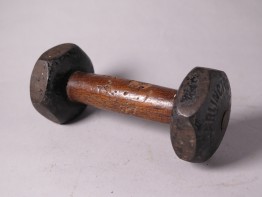Others
-
#1524 Liverpool Retailed Antique Small Dumbell, circa 1880-1910 **SOLD** 2013
Only 1 left in stockA single small Victorian or Edwardian dumbell impressed on both ends with the retailer's name and address: J. Darlington, Slater Street, Liverpool.
Condition: well used but intact with no damages or losses.
12.5 cm (7 inches) long
-
#1636 Medieval Oak Panel from under Painted Chamber Palace of Westminster, Eleventh Century *Price on request*
Only 1 left in stockA rare and unusually large souvenir piece of wood cut from a beam from the painted chamber which was one of the oldest parts of the original Palace of Westminster (Houses of Parliament), destroyed by the Great Fire of 1834. This piece of oak forms the back of a Mahogany Coin Collector's Cabinet which was made circa 1835-1850.
The writing on this ancient wood panel reads: "The Oak forming this cabinet is part of a Beam removed from under the floor of the Painted Chamber (being part of the wood used in the original building in the reign of Edward the Confessor) and removed after the fire of Thursday October 16th, 1834 by permission of the Honorable Commissioner .. of His Majesty's Woods & Forests by ...." We have not deciphered the name and signature at the bottom and we have not yet identified the wax seal (bottom left).
Condition: the panel is split in two vertically and there are very old horizontal cracks visible top left. The panel is 29.2 cm (11.5 inches) high; 24.1cm (9.5 inches) high. The mahogany cabinet is heavy and is
33 cm (13 inches) high; 31.8cm (12.5 inches) wide and 30.5cm (12 inches) deep
According to the official parliament website (www.parliament.uk) "In the 13th century King Henry III .. built .. the Painted Chamber as a private apartment on foundations in parallel to the present-day St Stephen's Hall, and it is said that St Edward the Confessor had died in a room which previously occupied the site." "The room was as grand and as colourful as the King (Henry III) and his craftsmen could make it. It was long and narrow, and housed a canopied state bed at one end. "The destruction of the Painted Chamber was perhaps the greatest artistic loss of the fire that ravaged Parliament in 1834. One of the wonders of medieval Europe, it was named after its magnificent thirteenth-century wall paintings of biblical kings, virtues and vices, and the coronation of Edward the Confessor." http://www.parliament.uk/worksofart/artwork/t-clark/interior-of-painted-chamber-after-the-fire-1834/1638




